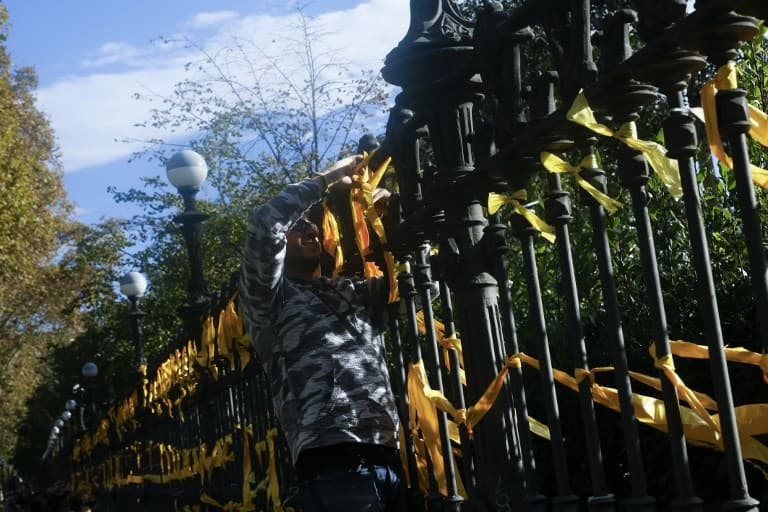ANALYSIS: Are hardline Catalan separatists really going to attempt a violent breakaway?

Hunger strike, sabotage, calls for revolution and reckless unchecked protests. How far will some militant Catalan separatists go?
In 1991, Slovenia fought a 10-day war with Serbia over its independence, as Yugoslavia began to disintegrate. Flags were taken down, tanks were burnt, bases surrounded and helicopters shot down. “Rough estimates” suggest 75 people were killed and more than 320 injured.
The First Minister of Catalonia, Quim Torra, said this weekend that the “Slovene path”, which he characterised as “freedom”, was the one for the north-eastern Spanish region to follow in 2018: “The Slovenes decided to move forward with all the consequences. Let’s do like they did and be ready for everything to live freely”.
The Mayor of Barcelona, Ada Colau, condemned the remarks as “gravely irresponsible”. Columns have appeared urgently warning against any such madness. In ABC, Hermann Tertsch, who was there in 1991 “at the time and the place the ‘Slovene path’ was first applied”, recalled that the first effect was “the six smoking bodies of Yugoslav Army recruits inside an armoured fighting vehicle. One had managed to open the hatch but none got out. Members of the Slovene territorial defence force had hit them with a grenade launcher”. In El Mundo, David Gistau began his piece with “what Torra needs is for someone to take him to see a dead body”.
READ MORE: Catalan leader slammed for urging 'Slovenian route' to secession
Also over the weekend, the separatist protest groups known as the CDRs (“Republican Defence Committees”), who were busy blocking the AP7 motorway in Catalonia and opening the toll booths, underwent something of an even more radical transformation, on their Telegram channels at least, with the birth of the GAAR (“Autonomous Quick Action Groups”).
Their first pdf “communiqué”, in the style of 20th-century revolutionary terror groups, complete with a red and black star logo, promised “boicot and sabotage”, which implies things will be broken, because "we voted for independence, not regional government". The list of things to be sabotaged includes “cars and roads, railways, the underground and trams, industrial areas, forces of order (police) [and] cable communications”. They said they would begin their revolutionary actions on December 21st "and will only stop when the Catalan Republic is proclaimed".
Also clamouring for revolutionary violence, on YouTube and Facebook, was a man called Fredi Bentenachs, who was one of the founding members of Terra Lliure, the now defunct Catalan marxist separatist terror group from the 1970s and 80s. On December 21st, the central Spanish government plans to hold a cabinet meeting in Barcelona. Separatist groups plan to disrupt the event. The Public Works Minister, José Luis Ábalos, suggested on Tuesday morning that the government might not now go ahead with the meeting.
Mr. Ábalos wrote one of three letters the central government sent to the regional executive on Monday evening ordering them to restore order in the Catalan Police immediately and have them enforce the law in the region. The specific events that have led to the letters are the motorway protests over the weekend.
The Home Secretary, Fernando Grande Marlaska, noted the Catalan Police had stood around and done nothing to stop the protesters. One video even showed two or three officers, instead of ensuring the rights of all and road safety, asking them if they wouldn’t mind moving out of the way a bit. In their rulings, judges investigating last year’s crisis have been keenly aware of the possible threat posed by 17,000 armed officers responding to the orders of separatist leaders and not the courts.
This time, as well as the usual tire and stick barricade, the CDR members had very recklessly ripped off a section of motorway barrier to lay across the road. One lorry carrying dangerous materials got stuck on it. There was nearly physical violence between the lorry drivers and the separatists after the drivers, thoroughly fed up, began to remove the dead branches on the barricade. And another video appeared of residents in a village nearly coming to blows over the yellow ribbons.
In Lledoners jail, four of the nine separatist leaders on remand say they have gone on hunger strike. Their spokeswoman said on Monday that they had lost between three and seven kilos each, after seven to ten days. They want the Constitutional Court to hear their appeals so that they can then appeal to European courts. Gandhi’s hunger strikes lasted up to 21 days; Bobby Sands and the other nine Irish republicans who died lasted between 46 and 73 days in 1981.
The spokeswoman told me yesterday she hoped she would not have to tell the world of that outcome in this case, but that the four politicians had not set an end-date for their prison protest.
So the question for Catalonia, and Spain, is once again one of rhetoric and reality. Last year’s crisis was very evidently not solved by the temporary suspension of home rule. As Carles Puigdemont represented a more entrenched nationalist leadership option compared to Artur Mas, so Quim Torra, who openly defends radical street violence and is now suggesting not very subtly that even more aggression might be the path forward, represents yet another step towards revolution. Lots of radical separatist voices, are suggesting the same option, violence or revolt, at the same time.
As well as being deeply irresponsible, it remains to be seen how many supporters will answer those clarion calls, decide the time has come to make something of a stand and actually start breaking things and hurting people. How far are some separatists willing to go?
Matthew Bennett is the creator of The Spain Report. You can read more of his writing on Patreon, and follow him on Twitter. Don't miss his podcast series with weekly in-depth analysis on Spain.

Comments
See Also
In 1991, Slovenia fought a 10-day war with Serbia over its independence, as Yugoslavia began to disintegrate. Flags were taken down, tanks were burnt, bases surrounded and helicopters shot down. “Rough estimates” suggest 75 people were killed and more than 320 injured.
The First Minister of Catalonia, Quim Torra, said this weekend that the “Slovene path”, which he characterised as “freedom”, was the one for the north-eastern Spanish region to follow in 2018: “The Slovenes decided to move forward with all the consequences. Let’s do like they did and be ready for everything to live freely”.
The Mayor of Barcelona, Ada Colau, condemned the remarks as “gravely irresponsible”. Columns have appeared urgently warning against any such madness. In ABC, Hermann Tertsch, who was there in 1991 “at the time and the place the ‘Slovene path’ was first applied”, recalled that the first effect was “the six smoking bodies of Yugoslav Army recruits inside an armoured fighting vehicle. One had managed to open the hatch but none got out. Members of the Slovene territorial defence force had hit them with a grenade launcher”. In El Mundo, David Gistau began his piece with “what Torra needs is for someone to take him to see a dead body”.
READ MORE: Catalan leader slammed for urging 'Slovenian route' to secession
Also over the weekend, the separatist protest groups known as the CDRs (“Republican Defence Committees”), who were busy blocking the AP7 motorway in Catalonia and opening the toll booths, underwent something of an even more radical transformation, on their Telegram channels at least, with the birth of the GAAR (“Autonomous Quick Action Groups”).
Their first pdf “communiqué”, in the style of 20th-century revolutionary terror groups, complete with a red and black star logo, promised “boicot and sabotage”, which implies things will be broken, because "we voted for independence, not regional government". The list of things to be sabotaged includes “cars and roads, railways, the underground and trams, industrial areas, forces of order (police) [and] cable communications”. They said they would begin their revolutionary actions on December 21st "and will only stop when the Catalan Republic is proclaimed".
Also clamouring for revolutionary violence, on YouTube and Facebook, was a man called Fredi Bentenachs, who was one of the founding members of Terra Lliure, the now defunct Catalan marxist separatist terror group from the 1970s and 80s. On December 21st, the central Spanish government plans to hold a cabinet meeting in Barcelona. Separatist groups plan to disrupt the event. The Public Works Minister, José Luis Ábalos, suggested on Tuesday morning that the government might not now go ahead with the meeting.
Mr. Ábalos wrote one of three letters the central government sent to the regional executive on Monday evening ordering them to restore order in the Catalan Police immediately and have them enforce the law in the region. The specific events that have led to the letters are the motorway protests over the weekend.
The Home Secretary, Fernando Grande Marlaska, noted the Catalan Police had stood around and done nothing to stop the protesters. One video even showed two or three officers, instead of ensuring the rights of all and road safety, asking them if they wouldn’t mind moving out of the way a bit. In their rulings, judges investigating last year’s crisis have been keenly aware of the possible threat posed by 17,000 armed officers responding to the orders of separatist leaders and not the courts.
This time, as well as the usual tire and stick barricade, the CDR members had very recklessly ripped off a section of motorway barrier to lay across the road. One lorry carrying dangerous materials got stuck on it. There was nearly physical violence between the lorry drivers and the separatists after the drivers, thoroughly fed up, began to remove the dead branches on the barricade. And another video appeared of residents in a village nearly coming to blows over the yellow ribbons.
In Lledoners jail, four of the nine separatist leaders on remand say they have gone on hunger strike. Their spokeswoman said on Monday that they had lost between three and seven kilos each, after seven to ten days. They want the Constitutional Court to hear their appeals so that they can then appeal to European courts. Gandhi’s hunger strikes lasted up to 21 days; Bobby Sands and the other nine Irish republicans who died lasted between 46 and 73 days in 1981.
The spokeswoman told me yesterday she hoped she would not have to tell the world of that outcome in this case, but that the four politicians had not set an end-date for their prison protest.
So the question for Catalonia, and Spain, is once again one of rhetoric and reality. Last year’s crisis was very evidently not solved by the temporary suspension of home rule. As Carles Puigdemont represented a more entrenched nationalist leadership option compared to Artur Mas, so Quim Torra, who openly defends radical street violence and is now suggesting not very subtly that even more aggression might be the path forward, represents yet another step towards revolution. Lots of radical separatist voices, are suggesting the same option, violence or revolt, at the same time.
As well as being deeply irresponsible, it remains to be seen how many supporters will answer those clarion calls, decide the time has come to make something of a stand and actually start breaking things and hurting people. How far are some separatists willing to go?
Matthew Bennett is the creator of The Spain Report. You can read more of his writing on Patreon, and follow him on Twitter. Don't miss his podcast series with weekly in-depth analysis on Spain.

Join the conversation in our comments section below. Share your own views and experience and if you have a question or suggestion for our journalists then email us at [email protected].
Please keep comments civil, constructive and on topic – and make sure to read our terms of use before getting involved.
Please log in here to leave a comment.